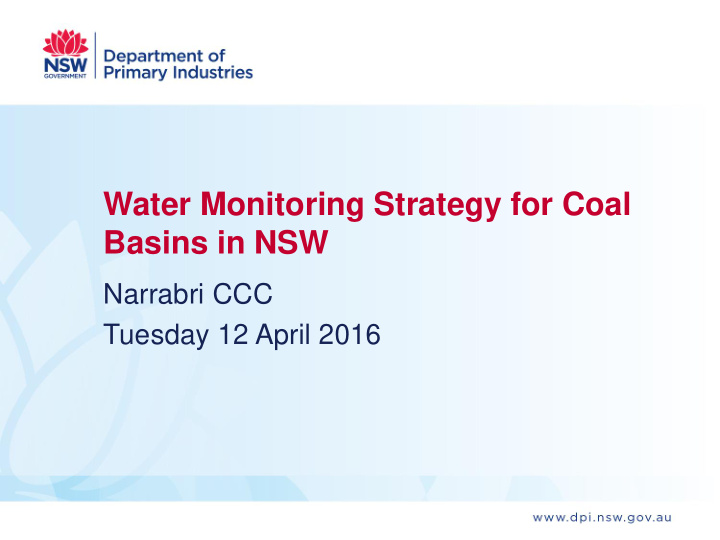



Water Monitoring Strategy for Coal Basins in NSW Narrabri CCC Tuesday 12 April 2016
Purpose of this meeting • Overview of the Water Monitoring Strategy • Site selection • Discussion
The team Christobel Ferguson – Director – Water Information and Insights, DPI Water Sarah Wylie – Project Director, NSW Public Works Rob Brownbill – Senior Hydrogeologist, DPI Water Andrew Cruckshank – Project Manager, NSW Public Works Kath Logan – Stakeholder Relations Manager, NSW Public Works Cate Barrett – Hydrogeologist, DPI Water
Better business as usual • DPI Water operates a groundwater monitoring network – 5000+ bores, 3000+ locations • In 2014, the NSW government allocated $22.8M to the Water Monitoring Strategy • The groundwater monitoring network will be expanded to better map, monitor and protect groundwater resources
Water Monitoring Strategy • Expand groundwater water monitoring bore network • Better information = better decisions • Make information publicly available
Groundwater monitoring information • Baseline groundwater conditions • Monitor changes in groundwater (levels, quality) • Monitor natural seasonal fluctuation • Monitor long term trends • Geology
Information produced • Resource management and assessment • Inform users and other stakeholders • Inform groundwater modelling • Research
Site selection criteria include: • Data gap • Modelling characterisation • Active use area • Inter-aquifer connectivity • Surface/groundwater connectivity • Water quality • Ecological and cultural significance
Proposed site locations 0 1.5 3 6 9 12 WMF Gunnedah Basin Proposed Monitoring Sites Narrabri Area Kilometers ^ _ _ ^ Proposed Sites ^ _ Jack Creek Rd Namoi Catchment Plumb Rd _ ^ ´
Site information Jacks Creek Rd - target geology: • Shallow - Pilliga Sandstone or Garrawilla Volcanics • Deep - Gunnedah Basin Plumb Rd - target geology: • Shallow - Pilliga Sandstone. • Intermediate – Deriah Formation sandstone • Deep – Digby Formation conglomerate
Final site set up
Recommend
More recommend